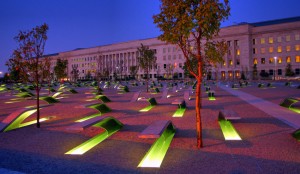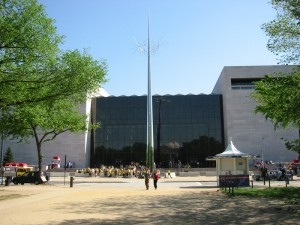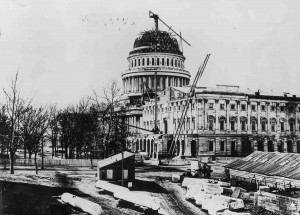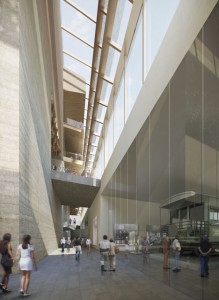Many student travel groups heading to New York City will visit the new 911 Memorial and Museum. This phenomenal new National 9/11 Memorial is open to the public now and will be visited by many.
 Did you know there is also a National 9/11 Pentagon Memorial in Washington D.C.? The memorial marks the site of the crash of American Airlines Flight 77. The large-scale outdoor memorial illustrates each person’s life with a line that begins with a birth year and ends on September 11, 2001. Prior to seeing the actual memorial, student groups will pass through the Memorial Gateway, where visitors will learn more about the Pentagon, and have time for reflection.
Did you know there is also a National 9/11 Pentagon Memorial in Washington D.C.? The memorial marks the site of the crash of American Airlines Flight 77. The large-scale outdoor memorial illustrates each person’s life with a line that begins with a birth year and ends on September 11, 2001. Prior to seeing the actual memorial, student groups will pass through the Memorial Gateway, where visitors will learn more about the Pentagon, and have time for reflection.
A Brief History of Pentagon’s Damage on 911
On September 11, 2001, American Airlines Flight 77 crashed into the west side of the Pentagon, after being hijacked by five terrorists. All on board Flight 77 died that day and so did nearly one hundred employees of the Pentagon, for a total of 184 people. This section of the building was demolished and reconstructed. The building was created with safer construction features (such as walls and windows that can withstand blasts), and the new design deliberately excludes the escalator that used to connect the Pentagon to the Metro station.
911 Memorial Description
The exact position of the memorial is at the point of the plane’s impact that day, and there is even a black stone in the new foundation of the Pentagon, pulled from the demolition, that is inscribed with the date. Each life lost is marked with the year the person was born, with a line extending out towards September 11, 2001. Each memorial culminates in a bench made from marble and stainless steel and is inscribed with the person’s name. The National 911 Memorial at the Pentagon was dedicated in a public ceremony that included the families and loved ones of survivors in 2008, making it the first of the three national memorial sites (including New York City, World Trade Center and Shanksville, Pennsylvania) to be open to the public.
The 911 Memorial at the Pentagon is one aspect of the student trip to the Pentagon. Provided there is enough advance planning, student tour groups headed to the Washington D.C. area can visit parts of the Pentagon that are accessible to the public and learn more about the military’s rich history and role in maintaining a democratic nation.
Is the Pentagon Accessible for Student Tour Groups?
In the post-911 era, procedures and rules when visiting a government building have changed. Despite heightened concerns about security, the Pentagon has done an excellent job of keeping the building open to student group tours. The tour guides at the Pentagon are staff members assigned the duty of conducting tours for a one-year period. Approximately 50 Pentagon employees are assigned the duty of taking students and other types of tour groups throughout this huge facility, and they are imminently qualified to do so.
Student Trips to Washington D.C. Consider Touring the Pentagon
In this age of technological and traditional warfare, the largest military installation in the U.S. is heavily guarded and has special rules for those who attend the 90-minute tours. These tours offer a thorough overview of all branches of the military and a history of commemorative battles fought, so they are well worth it from an educational point of view. For the ROTC student, and for the student thinking of enlisting in the military, a tour of the Pentagon will be fascinating. These students will certainly learn more about the history and battles of their chosen branch of the military.
However, if all procedures are not honored by the entire student travel group, students will not be allowed to participate in the Pentagon tour. Just over 100,000 people toured the Pentagon last year, so it is certainly a privilege. Tours can be booked 14-90 days in advance. Trip leaders and teachers need to let a qualified student travel company know of a student group’s intentions to take the Pentagon tour in the planning stages of trip to Washington D.C.
Student Travelers Must Follow Procedures for Pentagon Tour
Students cannot carry backpacks or camera bags, and pocketbooks will be subject to search. Electronic devices of any kind are not permitted on tour – including cell phones and smartphones. No food or beverages or tobacco products are allowed on tour, nor are weapons or sharp objects that could be used as weapons permitted. All students on the Pentagon tour must have photo identification to be presented prior to beginning the tour. Making sure each high school student has a proper identification, whether they hold a driver’s license or not, is a detail that needs to be confirmed before students board busses or planes for trips to Washington D.C. It is important that Pentagon staff have an accurate record of persons entering and leaving the building.
The most challenging guidelines for today’s tech savvy high school student to observe will be the surrender of cell phones and other electronic devices. This informative tour will include nearly a mile and a half of walking. The immense size of the Pentagon and its history are sure to impress many students.
What Student Groups Can Learn from a Visit to the Pentagon
Because it houses leadership of the national defense, the Pentagon is a building that has airs of secrecy and mystery about it. Prior to an actual visit, it is likely many students’ opinions about the Pentagon may have been formed from watching television and movies.
Hollywood’s portrayals of Pentagon activities do not always reflect reality. Nor do fictional images of the Pentagon show the initiative, knowledge and skills behind the nearly 23,000 civilian and military employees who work at this complex everyday. Pentagon staff performs an array of duties that are integral to our nation’s defense. By attending a Pentagon Tour, students will come away with more knowledge about warfare, and the way in which U.S. soldiers have distinguished themselves throughout history. After a visit, student’s viewpoint of the Pentagon will be more accurate.
To schedule a student trip to Washington D.C. that includes a tour of the Pentagon, visit http://www.educationaltravelconsultants.com.












